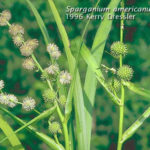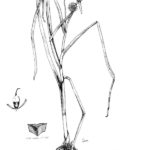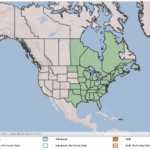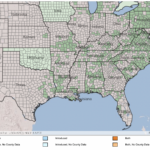Sparganium americanum
USDA, NRCS. 2018. The PLANTS Database (http://plants.usda.gov, 28 March 2018). National Plant Data Team, Greensboro, NC 27401-4901 USA.
Illustration courtesy of University of Florida/IFAS Center for Aquatic and Invasive Plants. Used with permission.
What is American Bur-Reed?
Physical Characteristics
Leaves:
- Strap-like
- Thick
- Up to 1 inch wide
- Bright green in color
- Taller than the flower
- Flat on top
Flowers:
- Large
- Spherical
- Bur-like
- Clustered
- About 1 inch in diameter
- Green at first, turning brown with age
- Blooms May- Aug
Fruit:
- Dry
- One seeded
- Does not open to release seed when ripe
Stem:
- Up to 2 feet tall
- Grass-like
- Erect
Where Does it Grow?
America bur-reed can be found in shallow waters with partial shade in wet marshes and along the edges of ponds and lakes.
Pros and Cons of American Bur-Reed
The seeds are eaten by waterfowl and marsh birds, and muskrats feed on the entire plant. Submerged portions of all aquatic plants provide habitats for many micro and macro invertebrates. These invertebrates in turn are used as food by fish and other wildlife species (e.g. amphibians, reptiles, ducks, etc.). After aquatic plants die, their decomposition by bacteria and fungi provides food (called “detritus”) for many aquatic invertebrates.



